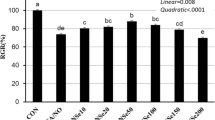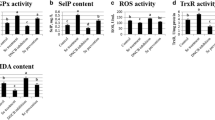Abstract
Selenium, in the form of selenoproteins, plays a pivotal role in anti-inflammatory processes and antioxidant defense system. The aim of this study was to examine the effects of selenium on lipopolysaccharide (LPS)-induced inflammatory responses in bovine mammary epithelial cells (bMEC) and to investigate the potential mechanism. bMEC viability was measured by MTT assay. TNF-α, IL-1β, cyclooxygenase-2 (COX-2), and inducible nitric oxide synthase (iNOS) messenger RNA (mRNA) expressions were evaluated by quantitative real-time polymerase chain reaction (qRT-PCR). The activation of nuclear factor-kappa B (NF-κB) was determined by Western blotting. The results showed that the mRNA expressions of these inflammatory factors were significantly inhibited by selenium in a dose-dependent manner. At protein levels, Western blot analysis demonstrated that selenium dose-dependently decreased NF-κB p65 translocating from the cytoplasm to the nucleus. Taken together, these results suggest that the anti-inflammatory property of selenium in LPS-stimulated primary bMEC may be attributed to the downregulation of NF-κB activation.




Similar content being viewed by others
References
Cavero, D., K.-H. Tölle, C. Henze, C. Buxadé, and J. Krieter. 2008. Mastitis detection in dairy cows by application of neural networks. Livestock Science 114: 280–286.
Seegers, H., C. Fourichon, and F. Beaudeau. 2003. Production effects related to mastitis and mastitis economics in dairy cattle herds. Veterinary Research 34: 475–491.
Sharma, N., N. Singh, and M. Bhadwal. 2011. Relationship of somatic cell count and mastitis: an overview. Asian-Australasian Journal of Animal Sciences 24: 429–438.
Ibeagha-Awemu, E.M., J.-W. Lee, A.E. Ibeagha, D.D. Bannerman, M.J. Paape, and X. Zhao. 2008. Bacterial lipopolysaccharide induces increased expression of toll-like receptor (TLR) 4 and downstream TLR signaling molecules in bovine mammary epithelial cells. Veterinary Research 39: 1–12.
Hoffmann, P.R., and M.J. Berry. 2008. The influence of selenium on immune responses. Molecular Nutrition & Food Research 52: 1273–1280.
Duntas, L. 2009. Selenium and inflammation: underlying anti-inflammatory mechanisms. Hormone And Metabolic Research = Hormon- Und Stoffwechselforschung = Hormones Et Metabolisme 41: 443–447.
Guo, F., N. Monsefi, A. Moritz, and A. Beiras-Fernandez. 2012. Selenium and cardiovascular surgery: an overview. Current Drug Safety 7: 321–327.
Miggiano, G., and L. Gagliardi. 2004. Diet, nutrition and rheumatoid arthritis. La Clinica Terapeutica 156: 115–123.
Kravtsiv, R., A. Stadnyk, and M. Lychuk. 2003. Antioxidant vitamins and selenium in the prevention of white muscle disease in calves. Ukrainskiĭ Biokhimicheskiĭ Zhurnal 76: 90–99.
Zamamiri-Davis, F., Y. Lu, J.T. Thompson, K.S. Prabhu, P.V. Reddy, L.M. Sordillo, et al. 2002. Nuclear factor-κB mediates over-expression of cyclooxygenase-2 during activation of RAW 264.7 macrophages in selenium deficiency. Free Radical Biology & Medicine 32: 890–897.
Prabhu, K., F. Zamamiri-Davis, J. Stewart, J. Thompson, L. Sordillo, and C. Reddy. 2002. Selenium deficiency increases the expression of inducible nitric oxide synthase in RAW 264.7 macrophages: role of nuclear factor-κB in up-regulation. Biochemical Journal 366: 203–209.
Zhang W, Zhang R, Wang T, Jiang H, Guo M, Zhou E, et al. 2013. Selenium inhibits LPS-induced pro-inflammatory gene expression by modulating MAPK and NF-κB signaling pathways in mouse mammary epithelial cells in primary culture. Inflammation 1–8.
Fu, Y., B. Liu, X. Feng, Z. Liu, D. Liang, F. Li, et al. 2013. Lipopolysaccharide increases Toll-like receptor 4 and downstream Toll-like receptor signaling molecules expression in bovine endometrial epithelial cells. Veterinary Immunology and Immunopathology 151: 20–27.
Fu, Y., B. Liu, N. Zhang, Z. Liu, D. Liang, F. Li, et al. 2013. Magnolol inhibits lipopolysaccharide-induced inflammatory response by interfering with TLR4 mediated NF-κB and MAPKs signaling pathways. Journal of Ethnopharmacology 145: 193–199.
Rossol M, Heine H, Meusch U, Quandt D, Klein C, Sweet MJ, et al. 2011. LPS-induced cytokine production in human monocytes and macrophages. Critical Reviews™ in Immunology 31.
Andrieu, S. 2008. Is there a role for organic trace element supplements in transition cow health? The Veterinary Journal 176: 77–83.
Spears, J.W., and W.P. Weiss. 2008. Role of antioxidants and trace elements in health and immunity of transition dairy cows. The Veterinary Journal 176: 70–76.
Rayman, M.P. 2012. Selenium and human health. The Lancet 379: 1256–1268.
Lee, J.-W., D.D. Bannerman, M.J. Paape, M.-K. Huang, and X. Zhao. 2006. Characterization of cytokine expression in milk somatic cells during intramammary infections with Escherichia coli or Staphylococcus aureus by real-time PCR. Veterinary Research 37: 219–229.
Hwang, P.-A., S.-Y. Chien, Y.-L. Chan, M.-K. Lu, C.-H. Wu, Z.-L. Kong, et al. 2011. Inhibition of lipopolysaccharide (LPS)-induced inflammatory responses by Sargassum hemiphyllum sulfated polysaccharide extract in RAW 264.7 macrophage cells. Journal of Agricultural and Food Chemistry 59: 2062–2068.
Buraczynska, M., P. Ksiazek, P. Kubit, and W. Zaluska. 2006. Interleukin-1 receptor antagonist gene polymorphism affects the progression of chronic renal failure. Cytokine 36: 167–172.
Oviedo-Boyso, J., J.J. Valdez-Alarcon, M. Cajero-Juarez, A. Ochoa-Zarzosa, J.E. Lopez-Meza, A. Bravo-Patino, et al. 2007. Innate immune response of bovine mammary gland to pathogenic bacteria responsible for mastitis. The Journal of Infection 54: 399–409.
Li, D., N. Zhang, Y. Cao, W. Zhang, G. Su, Y. Sun, et al. 2013. Emodin ameliorates lipopolysaccharide-induced mastitis in mice by inhibiting activation of NF-kappaB and MAPKs signal pathways. European Journal of Pharmacology 705: 79–85.
Smith, W.L., and R. Langenbach. 2001. Why there are two cyclooxygenase isozymes. Journal of Clinical Investigation 107: 1491–1495.
Feng, L., Y. Xia, G. Garcia, D. Hwang, and C. Wilson. 1995. Involvement of reactive oxygen intermediates in cyclooxygenase-2 expression induced by interleukin-1, tumor necrosis factor-alpha, and lipopolysaccharide. Journal of Clinical Investigation 95: 1669.
Cho, H., C.-W. Yun, W.-K. Park, J.-Y. Kong, K.S. Kim, Y. Park, et al. 2004. Modulation of the activity of pro-inflammatory enzymes, COX-2 and iNOS, by chrysin derivatives. Pharmacological Research 49: 37–43.
Vunta, H., B.J. Belda, R.J. Arner, C. Channa Reddy, J.P. Vanden Heuvel, and P.K. Sandeep. 2008. Selenium attenuates pro‐inflammatory gene expression in macrophages. Molecular Nutrition & Food Research 52: 1316–1323.
Lawrence, T., D.W. Gilroy, P.R. Colville-Nash, and D.A. Willoughby. 2001. Possible new role for NF-κB in the resolution of inflammation. Nature Medicine 7: 1291–1297.
Zhang, G., and S. Ghosh. 2001. Toll-like receptor–mediated NF-κB activation: a phylogenetically conserved paradigm in innate immunity. Journal of Clinical Investigation 107: 13–19.
Pantano, C., N.L. Reynaert, A.V.D. Vliet, and Y.M. Janssen–Heininger. 2006. Redox-sensitive kinases of the nuclear factor-κB signaling pathway. Antioxidants & Redox Signaling 8: 1791–1806.
Vunta, H., F. Davis, U.D. Palempalli, D. Bhat, R.J. Arner, J.T. Thompson, et al. 2007. The anti-inflammatory effects of selenium are mediated through 15-deoxy-Δ12, 14-prostaglandin J2 in macrophages. Journal of Biological Chemistry 282: 17964–17973.
Ricote, M., A.C. Li, T.M. Willson, C.J. Kelly, and C.K. Glass. 1998. The peroxisome proliferator-activated receptor-γ is a negative regulator of macrophage activation. Nature 391: 79–82.
Pascual, G., A.L. Fong, S. Ogawa, A. Gamliel, A.C. Li, V. Perissi, et al. 2005. A SUMOylation-dependent pathway mediates transrepression of inflammatory response genes by PPAR-γ. Nature 437: 759–763.
Acknowledgments
This study was supported by China Postdoctoral Science Foundation (2013 M540255).
Author information
Authors and Affiliations
Corresponding author
Additional information
Zhengkai Wei and Minjun Yao contributed equally to this work.
The authors hereby retract the article entitled “Inhibition of Lipopolysaccharide (LPS)-Induced Inflammatory Responses by Selenium in Bovine Mammary Epithelial Cells in Primary Culture” (Wei et al. 2014) published in Inflammation, Volume 38 / Issue 1 (February 2015) because of inappropriate statistical analysis and inability to reproduce some of the results.
About this article
Cite this article
Wei, Z., Yao, M., Li, Y. et al. RETRACTED ARTICLE: Inhibition of Lipopolysaccharide (LPS)-Induced Inflammatory Responses by Selenium in Bovine Mammary Epithelial Cells in Primary Culture. Inflammation 38, 152–158 (2015). https://doi.org/10.1007/s10753-014-0017-9
Published:
Issue Date:
DOI: https://doi.org/10.1007/s10753-014-0017-9




